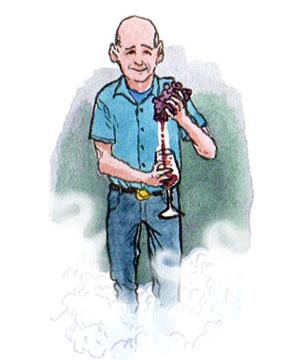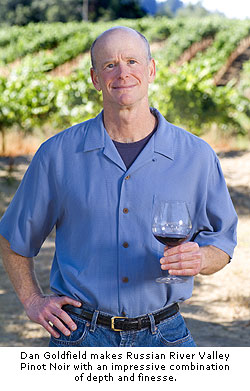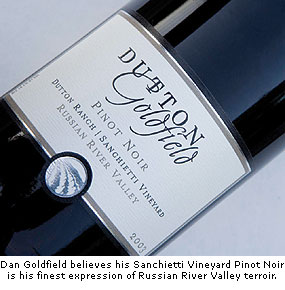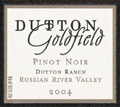

Dan Goldfield's Pinot Noirs are amongst the best examples made in the foggy environ of the Russian River Valley.
Discovering Russian River Pinot with Dan Goldfield
"Philosophically, I don’t think of this as the best winegrowing region in the world. I love wines from elsewhere in the world as well. But you can say it’s unique and it’s a real challenge to make wines here."
by
Dan Berger
October 30, 2006
Dan Berger (DB): Since you chose Russian River Valley as the place where you’ll make your mark, does that imply that you view it as the finest winegrowing region in the world?
Dan Goldfield (DG): Philosophically, I don’t think of this as the best winegrowing region in the world. I love wines from elsewhere in the world as well. But you can say it’s unique and it’s a real challenge to make wines here.
 DB: What sets this region apart from others in which you’ve worked?
DB: What sets this region apart from others in which you’ve worked?
DG: A unique expression of fruit is what I look for in any region, and in that vein, I think Russian River Valley has a unique personality, just as I think some of Marin County has a unique personality.
DB: What is the most appealing aspect of Russian River?
DG: The ability to get moderate alcohol and still get the right flavors. There is a purity of fruit and a brightness here.
DB: You also get fruit from Marin County. How does that compare with Russian River Valley?
DG: Marin has a bit of lower-tone fruit, more leather in the wines, and it’s one of the coldest places that I get fruit from. It’s colder than parts of the Sonoma Coast. Marin is more like Freestone. On the true Sonoma Coast, where Flowers is located (up the hill from Fort Ross), it’s actually warmer. They pick earlier than Marin County. Even though Flowers is at a 2,000-foot elevation, there is no heavy fog.
DB: Speaking of fog, wouldn’t you agree that it is the key aspect to Russian River Valley?
DG: Yes, and we’ve had a lot of fog in the last two weeks (mid-September). It’s what marks the difference between this region and so many others in Sonoma County.
DB: Describe the attractiveness of the fruit here.
DG: Russian River Valley delivers a fruit basket. We get less plums and more raspberries in the Zin. You get none of the cherry cough syrup that’s evident in Zins from the warmer areas. In the Pinot [Noir], we get a bright cherry fruit and a fine grain of tannins, I love the Marin Pinot I get, but there is a silkiness of the tannins here. The tannins can be substantial, but they are far more silky than in other places that are also cool.
DB: How was the 2004 vintage for you?
DG: It was a noticeably warmer year, but ’04 was a classic. It was small in volume, and relatively fogless, but somehow the brightness of fruit still came though. The challenge was to deal with the fact that the ripeness of the fruit came on so fast.
DB: It would seem that the erratic nature of the fog might lead to this being an inconsistent region. Is it?
DG: In terms of consistency, I don’t think any place in the world beats Russian River. But ’04 was a super-hot year and we were worried about it. When the wines were fermenting, I worried that they would be odd and perhaps tannic, but I ended up loving the ’04s.
DB:: How did you deal with the possible higher level of tannins in that vintage?
DG: I worked at it -- a little shorter time in the fermenter and I pressed off earlier. You typically extract more tannins at higher alcohols, and I didn’t want additional tannin.
 DB: What is your favorite wine that you make?
DB: What is your favorite wine that you make?
DG: Well, I love the Zins and the Syrah, but I don’t think you can find a more prototypical example of Russian River Valley Pinot Noir than the [one I make from] Sanchietti [Vineyard]. To me, it’s the most archetypal wine we make. This is the wine I define as Russian River Valley. It has all the aromas and flavors we look for in a great Pinot.
We sell 85% of our wines through distributors, and the wholesalers love to sell it to restaurants. But we make only 400 cases of it, so you almost never find it at retail. As a result we sell about 50% of it directly to consumers. At $55, we think of it as one of the best examples of Pinot Noir anywhere.
DB: What is the secret to that wine?
DG: Older vines. History matters, and older vineyards are prizes. And also, it is a unique statement of its terroir. There is nothing like the Sanchietti.
DB: As you may infer, this is a passionate but quite realistic man who has created some of the most prototypical, regional wines from an AVA. And not just any AVA either. Russian River Valley is now widely accepted as the best spot in California from which to extract from the petulant Pinot grape the essence of the variety as exhibited in a cool climate.
~ Dan Berger, Editor-At-Large
To comment on Dan Berger’s writings and thoughts, contact him at d.berger@appellationamerica.com
Dan Goldfield (DG): Philosophically, I don’t think of this as the best winegrowing region in the world. I love wines from elsewhere in the world as well. But you can say it’s unique and it’s a real challenge to make wines here.
 DB: What sets this region apart from others in which you’ve worked?
DB: What sets this region apart from others in which you’ve worked?DG: A unique expression of fruit is what I look for in any region, and in that vein, I think Russian River Valley has a unique personality, just as I think some of Marin County has a unique personality.
DB: What is the most appealing aspect of Russian River?
DG: The ability to get moderate alcohol and still get the right flavors. There is a purity of fruit and a brightness here.
DB: You also get fruit from Marin County. How does that compare with Russian River Valley?
DG: Marin has a bit of lower-tone fruit, more leather in the wines, and it’s one of the coldest places that I get fruit from. It’s colder than parts of the Sonoma Coast. Marin is more like Freestone. On the true Sonoma Coast, where Flowers is located (up the hill from Fort Ross), it’s actually warmer. They pick earlier than Marin County. Even though Flowers is at a 2,000-foot elevation, there is no heavy fog.
DB: Speaking of fog, wouldn’t you agree that it is the key aspect to Russian River Valley?
DG: Yes, and we’ve had a lot of fog in the last two weeks (mid-September). It’s what marks the difference between this region and so many others in Sonoma County.
DB: Describe the attractiveness of the fruit here.
DG: Russian River Valley delivers a fruit basket. We get less plums and more raspberries in the Zin. You get none of the cherry cough syrup that’s evident in Zins from the warmer areas. In the Pinot [Noir], we get a bright cherry fruit and a fine grain of tannins, I love the Marin Pinot I get, but there is a silkiness of the tannins here. The tannins can be substantial, but they are far more silky than in other places that are also cool.
DB: How was the 2004 vintage for you?
DG: It was a noticeably warmer year, but ’04 was a classic. It was small in volume, and relatively fogless, but somehow the brightness of fruit still came though. The challenge was to deal with the fact that the ripeness of the fruit came on so fast.
DB: It would seem that the erratic nature of the fog might lead to this being an inconsistent region. Is it?
DG: In terms of consistency, I don’t think any place in the world beats Russian River. But ’04 was a super-hot year and we were worried about it. When the wines were fermenting, I worried that they would be odd and perhaps tannic, but I ended up loving the ’04s.
DB:: How did you deal with the possible higher level of tannins in that vintage?
DG: I worked at it -- a little shorter time in the fermenter and I pressed off earlier. You typically extract more tannins at higher alcohols, and I didn’t want additional tannin.
 DB: What is your favorite wine that you make?
DB: What is your favorite wine that you make?DG: Well, I love the Zins and the Syrah, but I don’t think you can find a more prototypical example of Russian River Valley Pinot Noir than the [one I make from] Sanchietti [Vineyard]. To me, it’s the most archetypal wine we make. This is the wine I define as Russian River Valley. It has all the aromas and flavors we look for in a great Pinot.
We sell 85% of our wines through distributors, and the wholesalers love to sell it to restaurants. But we make only 400 cases of it, so you almost never find it at retail. As a result we sell about 50% of it directly to consumers. At $55, we think of it as one of the best examples of Pinot Noir anywhere.
DB: What is the secret to that wine?
DG: Older vines. History matters, and older vineyards are prizes. And also, it is a unique statement of its terroir. There is nothing like the Sanchietti.
DB: As you may infer, this is a passionate but quite realistic man who has created some of the most prototypical, regional wines from an AVA. And not just any AVA either. Russian River Valley is now widely accepted as the best spot in California from which to extract from the petulant Pinot grape the essence of the variety as exhibited in a cool climate.
~ Dan Berger, Editor-At-Large
To comment on Dan Berger’s writings and thoughts, contact him at d.berger@appellationamerica.com










 of the Russian River Valley.
of the Russian River Valley.



